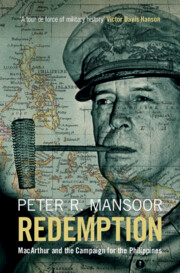Refine search
Actions for selected content:
6 results

Redemption
- MacArthur and the Campaign for the Philippines
-
- Published online:
- 14 August 2025
- Print publication:
- 14 August 2025
5 - Leyte Gulf
-
- Book:
- Redemption
- Published online:
- 14 August 2025
- Print publication:
- 14 August 2025, pp 174-220
-
- Chapter
- Export citation
4 - The Decision
-
- Book:
- Redemption
- Published online:
- 14 August 2025
- Print publication:
- 14 August 2025, pp 147-173
-
- Chapter
- Export citation
1 - Catastrophe
-
- Book:
- Redemption
- Published online:
- 14 August 2025
- Print publication:
- 14 August 2025, pp 1-50
-
- Chapter
- Export citation
11 - Rebirth
-
- Book:
- Redemption
- Published online:
- 14 August 2025
- Print publication:
- 14 August 2025, pp 418-436
-
- Chapter
- Export citation
Was There a Diplomatic Alternative? The Atomic Bombing and Japan's Surrender
-
- Journal:
- Asia-Pacific Journal / Volume 19 / Issue 20 / October 2021
- Published online by Cambridge University Press:
- 14 March 2025, e4
-
- Article
-
- You have access
- Open access
- Export citation
